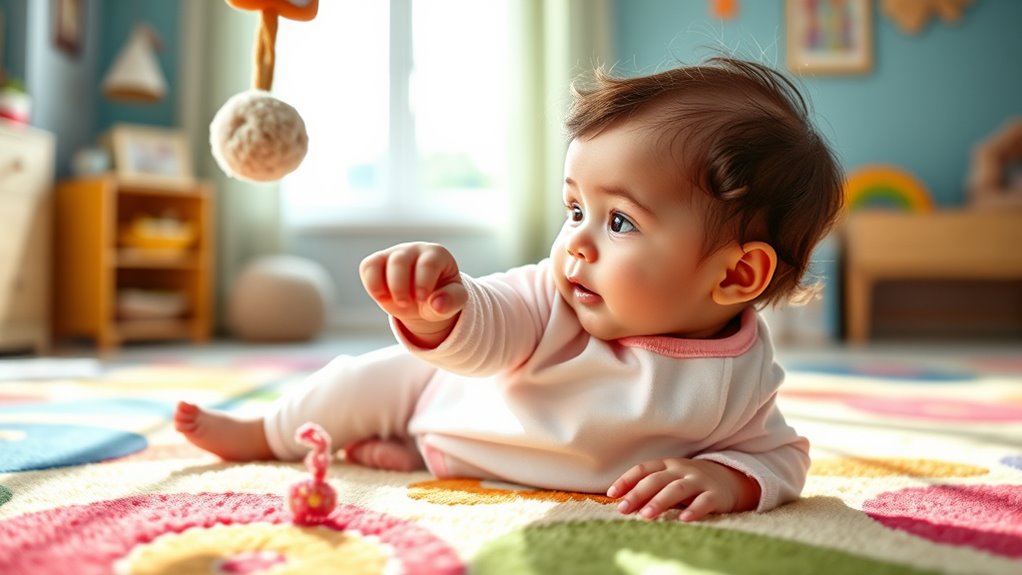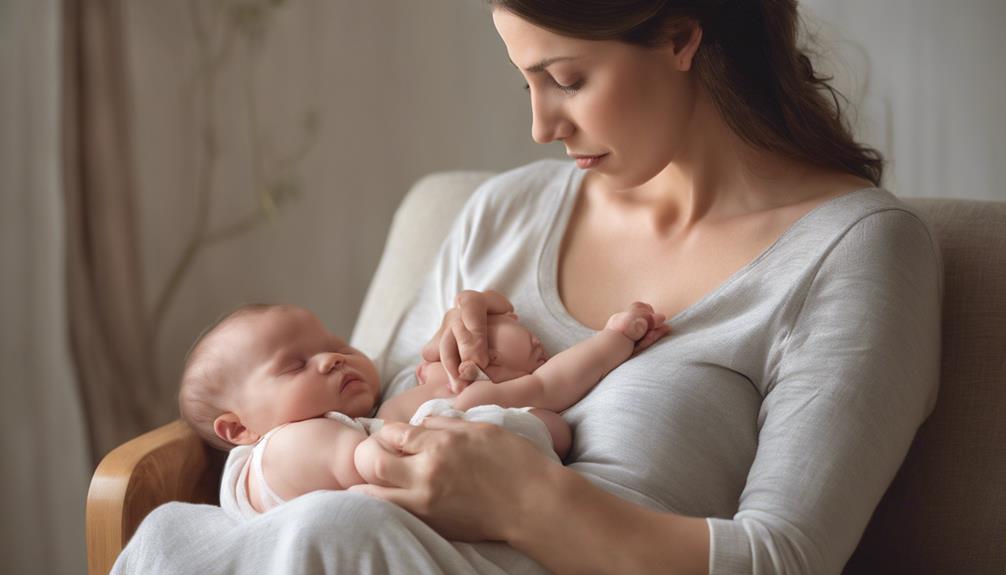Between 4 and 6 months, your baby becomes more active, beginning to roll over from tummy to back and vice versa. They’ll reach for objects intentionally, exploring textures and learning cause and effect with toys that light up or make noise. Their movements get more coordinated as they transfer objects between hands, strengthening their motor skills. They also smile, giggle, and respond more to familiar faces. Keep exploring together, and you’ll discover how their new skills continue to develop during this exciting stage.
Key Takeaways
- Between 4-6 months, babies develop the ability to roll over, enhancing strength and spatial awareness.
- Reaching and grasping objects become more intentional, improving hand-eye coordination.
- Active exploration through play supports sensory development and confidence in interacting with surroundings.
- Social interactions, like smiling and giggling, increase as babies recognize familiar faces and respond to sounds.
- Supervised play encourages motor skill growth and fosters emotional bonds with caregivers.

Between 4 and 6 months, your baby undergoes exciting developmental changes that lay the foundation for future growth. During this time, you’ll notice your little one becoming more curious about the world around them. Sensory exploration takes center stage as they reach for and grasp objects, feeling different textures and discovering new sensations. This active engagement helps strengthen their hand-eye coordination and fine motor skills. As they explore their environment, they also learn about cause and effect—like understanding that shaking a rattle produces a sound or that pressing a button makes a toy light up. These experiences are essential for their cognitive development and help build their confidence in interacting with objects. Incorporating educational toys that promote sensory and motor skills can further support their development during this stage. Social interaction also becomes more dynamic at this stage. Your baby starts to recognize familiar faces, smiling more often and perhaps even giggling at playful interactions. They may begin to imitate simple gestures or expressions, showing early signs of communication. Responding to their smiles and sounds encourages them to keep engaging and helps deepen your bond. You might notice them turning their head towards voices or looking at people more intently, keen to connect with those around them. These social cues are fundamental as they start to develop emotional awareness and understanding of social norms. Reaching and grasping become more intentional during these months. Your baby will likely start to stretch out their arms to grab toys or your fingers, demonstrating improved muscle control. They may also begin to transfer objects from one hand to the other, which is a significant milestone in developing coordination. As they practice these skills, they learn patience and perseverance, which are essential for future learning. Playtime becomes more interactive, and you’ll enjoy seeing them explore different toys and household items. Always supervise their play to guarantee safety, but give them plenty of opportunities to explore their surroundings freely. Rolling over is another milestone that signals their growing strength and coordination. Some babies may start rolling from tummy to back, while others progress to rolling from back to tummy. These movements are not only fun to watch but also help develop their core muscles and spatial awareness. As your baby masters rolling, they gain a new sense of independence and can move around more freely during play. All these developments—sensory exploration, social interaction, reaching, grasping, and rolling—combine to make these months a time of rapid growth and discovery. Your active involvement and encouragement are key to helping your baby thrive during this exciting stage.
Frequently Asked Questions
When Should I Worry if My Baby Isn’t Reaching for Objects?
If your baby isn’t reaching for objects by around 4 to 6 months, you might feel concerned, but developmental milestones vary. Usually, babies start reaching and grasping within this period, so if they haven’t yet, it’s okay to discuss your parental concerns with a pediatrician. They can assess your baby’s development and reassure you or suggest early interventions if needed. Trust your instincts and seek guidance if you’re worried.
How Can I Encourage My Baby to Roll Over More Often?
Imagine your baby on their tummy, surrounded by colorful toys. To encourage rolling, you can engage in sensory play by placing toys just out of reach, prompting them to reach and push off. Regular tummy time helps build motor skills and confidence. Consistently providing a safe, stimulating environment boosts their desire to explore and roll over more often. Keep it fun, and your baby will develop these skills naturally.
What Are Typical Signs of Early Cognitive Development?
You’ll notice your baby shows early cognitive signs through visual tracking and understanding object permanence. They’ll follow moving objects with their eyes and look for toys or objects even when out of sight. You might see them anticipate where a toy will reappear or reach for hidden items. These behaviors indicate their growing ability to understand the world around them, demonstrating important cognitive development milestones at this stage.
How Much Tummy Time Is Recommended for This Age?
You should aim for about 20 to 30 minutes of tummy time each day for your baby. Tummy time is vital because it helps develop their neck and shoulder muscles, which are key for reaching, rolling, and other milestones. Start with short sessions and gradually increase as your baby gets comfortable. Consistent tummy time supports their overall development and prepares them for crawling and other skills they’ll achieve soon.
When Will My Baby Start to Sit Independently?
Your baby typically starts sitting independently between 6 to 8 months as they develop key motor skill milestones. During this time, they also engage in sensory exploration, which helps strengthen their muscles and coordination. You can encourage this by providing safe, supportive environments for practice, offering plenty of tummy time, and allowing them to reach and pivot. Remember, each baby develops at their own pace, so patience is key.
Conclusion
At 4–6 months, your baby is like a tiny explorer, enthusiastic to reach, roll, and discover the world around them. Imagine their little hands stretching out, grasping new objects, and their eyes lighting up with curiosity. As they develop these skills, you’re witnessing the beginning of a grand adventure—each movement revealing a new chapter of growth and wonder. Embrace these moments; they’re the foundation of your baby’s incredible journey ahead.










